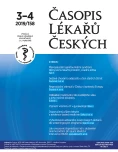Evaluation of the personalized invitation of Czech citizens to screening programs
Authors:
Ondřej Ngo 1,2; Renata Chloupková 1,2; Monika Ambrožová 1; Štěpán Suchánek 3; Miroslav Zavoral 3; Bohumil Seifert 4; Vladimír Dvořák 5; Jan Daneš 6; Miroslava Skovajsová 7; Ladislav Dušek 1,2; Ondřej Májek 1,2
Authors‘ workplace:
Ústav zdravotnických informací a statistiky České republiky, Praha
1; Institut biostatistiky a analýz, Lékařská fakulta MU, Brno
2; Interní klinika 1. LF UK a ÚVN – VoFN, Praha
3; Ústav všeobecného lékařství 1. LF UK, Praha
4; Centrum ambulantní gynekologie a primární péče, Brno
5; Radiodiagnostická klinika 1. LF UK a VFN v Praze
6; Breast Unit Prague, Mamma centrum Háje, Praha
7
Published in:
Čas. Lék. čes. 2019; 158: 147-150
Category:
Original Article
Overview
The Czech population has high burden of malignant tumors, and screening programs are therefore an essential part of cancer control policy. At the beginning of 2014 personalized invitation of Czech citizens for cancer screening programs was launched to promote higher coverage by screening. The aim of the paper is to present the up-to-date results of the personalized invitation. The data from health insurance companies were used to evaluate the volume of invitations for cancer screening programs and the participation rate after invitation in 2014–2017. During the first four years of the project, over 6 million invitations were sent (approximately 3 million individuals were invited). Participation rates after the first invitation in the breast, colorectal and cervical screening were 22.3%, 21.7% and 15.5%. However, the effect of personalized invitations decreases with repeated invitations to participate. Personalized invitation contributed to screening in hundreds of thousands citizens, but a large proportion of invited people still do not participate. It is necessary to encourage personalized invitation and discuss other strategies to motivate the public to participate in screening programs.
Keywords:
personalized invitation – cancer – mass screening – participation rate
Sources
-
Dušek L, Mužík J, Kubásek M, Koptíková J, Žaloudík J, Vyzula R. Epidemiologie zhoubných nádorů v České republice. Dostupné na: www.svod.cz
-
Kramer BS, Gohagan JK, Prorok PC (eds.). Cancer Screening: Theory and Practice. CRC Press, New York, 1999.
-
Nyström L, Rutqvist LE, Wall S et al. Breast cancer screening with mammography: overview of Swedish randomised trials. Lancet 1993; 341(8851): 973–978.
-
Hewitson P, Glasziou P, Watson E et al. Cochrane systematic review of colorectal cancer screening using the fecal occult blood test (hemoccult): an update. Am J Gastroenterol 2008; 103(6): 1541–1549.
-
Lăără E, Day NE, Hakama M. Trends in mortality from cervical cancer in the Nordic countries: association with organised screening programmes. Lancet 1987; 1(8544): 1247–1249.
-
European Council. Council Recommendation of 2 December 2003 on cancer screening. December 2003. Dostupné na: http://eur-lex.europa.eu/LexUriServ/LexUriServ.do?uri=OJ:L:2003 : 327 : 0034 : 0038:EN:PDF
-
Ponti A, Anttila A, Ronco G, Senore C. Cancer Screening in the European Union (2017). Report of the Implementation of the Council Recommendation on Cancer Screening, 2017.
-
Segnan N, Patnick J, von Karsa L. European guidelines for quality assurance in colorectal cancer screening and diagnosis – first edition. Office for official publications of the European communities, Luxembourg, 2010.
-
Perry N, Broeders M, de Wolf C et al. European guidelines for quality assurance in breast cancer screening and diagnosis. Office for official publications of the European communities, Luxembourg, 2006.
-
Arbyn M, Anttila A, Jordan J et al. European guidelines for quality assurance in cervical cancer screening. Office for official publications of the European communities, Luxembourg, 2008.
-
Weller D, Coleman D, Robertson R et al. The UK colorectal cancer screening pilot: results of the second round of screening in England. Br J Cancer 2007; 97(12): 1601–1605.
-
Logan RFA, Patnick J, Nickerson C et al. Outcomes of the Bowel Cancer Screening Programme (BCSP) in England after the first 1 million tests. Gut 2012; 61(10): 1439–1446.
-
Malila N, Palva T, Malminiemi O et al. Coverage and performance of colorectal cancer screening with the faecal occult blood test in Finland. J Med Screen 2011; 18(1): 18–23.
-
Giordano L, von Karsa L, Tomatis M et al. Mammographic screening programmes in Europe: organization, coverage and participation. J Med Screen 2012; 19(Suppl. 1): 72–82.
-
Anttila A, Ronco G; Working Group on the Registration and Monitoring of Cervical Cancer Screening Programmes in the European Union; within the European Network for Information on Cancer (EUNICE). Description of the national situation of cervical cancer screening in the member states of the European Union. Eur J Cancer Oxf Engl 2009; 45(15): 2685–2708.
-
Dušek L, Májek O, Blaha M a kol. Koncepce populačního screeningu v České republice, metodika a první výsledky adresného zvaní občanů do preventivních onkologických programů. Klinická onkologie 2014; 27(Suppl. 2): 2S59–2S68.
-
Ngo O, Bučková B, Suchánek Š a kol. Účast české populace na screeningu kolorektálního karcinomu: vývoj a aktuální stav. Gastroenterologie a hepatologie 2017; 71(5): 377–383.
Labels
Addictology Allergology and clinical immunology Angiology Audiology Clinical biochemistry Dermatology & STDs Paediatric gastroenterology Paediatric surgery Paediatric cardiology Paediatric neurology Paediatric ENT Paediatric psychiatry Paediatric rheumatology Diabetology Pharmacy Vascular surgery Pain management Dental HygienistArticle was published in
Journal of Czech Physicians

2019 Issue 3-4
- Metamizole at a Glance and in Practice – Effective Non-Opioid Analgesic for All Ages
- Advances in the Treatment of Myasthenia Gravis on the Horizon
- Metamizole in perioperative treatment in children under 14 years – results of a questionnaire survey from practice
- Possibilities of Using Metamizole in the Treatment of Acute Primary Headaches
- What Effect Can Be Expected from Limosilactobacillus reuteri in Mucositis and Peri-Implantitis?
Most read in this issue
- Tibolon – the only one member of STEAR’s group
- Genitourinary syndrome of menopause: hard to communicate, easy to treat
- Impact of the mother’s age at childbirth on the birth weight of new-born children
- Recommended fluid intake and evidence-based medicine
